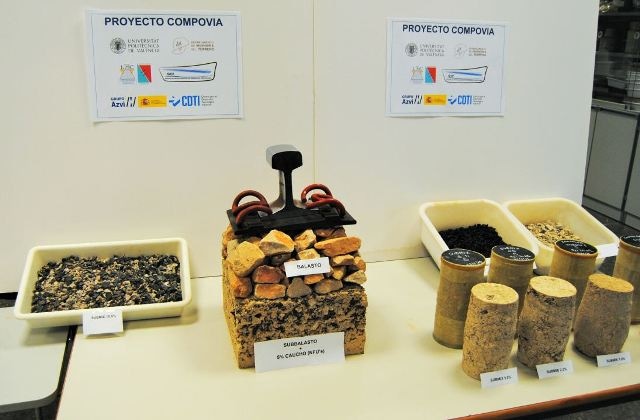Jul 18 2016
Scientists from the Polytechnic University of Valencia, the University of Seville and AZVI, a railway transport company, have jointly created a material that includes rubber from worn tires for use in the subballast layer of train tracks.
 Recycled tyre rubber in trackbed sub-ballast (Credit: Universitat Politècnica de València)
Recycled tyre rubber in trackbed sub-ballast (Credit: Universitat Politècnica de València)
This kind of mixture in combination with crushed stone has already been effectively used in roadside embankments and asphalt mixtures, however, the use of this material combination has not yet been explored in the rail sector.
The UPV technicians tested and assessed the new material along a portion of the Almoraima-Algeciras ADIF line in Andalusia. The new material not only allows and boosts the wholesale recycling of worn tires, a huge and difficult source of waste, but it also provides various benefits over conventional materials. For example, it takes in the vibrations from moving trains and provides insulation for urban locations with close rail traffic. Combining the tire rubber into the mixture also improves the crushed limestone’s resistance to fragmentation and abrasion.
There are multiple benefits to using this material. On the one side, it contributes to mitigating the vibrations caused by moving trains. But at the same time it opens up a new market for many of our quarries, particularly limestone quarries, as well as for tyre recycling companies. It revitalises both sectors, making better use of the available limestone, not normally fit for use as a sub-ballast because of its low resistance to fragmentation, and the rubber from used tyres.
Pablo Martínez Fernández, Researcher, University of Seville
As part of the project the Ricardo Insa-led team, designed, developed, and assessed numerous compositions and mixtures of the new material, varying only the quantity of waste rubber used consistently.
“From our laboratories at the Departamento de Ingeniería del Terreno (DIT) we analysed the response of the new material, with different concentrations of used tyre rubber, in order to find the best composition”, says Carlos Hidalgo Signes, also of the UPV.
Another main characteristic of this material is that it does not include any binding materials: “We simply mix the crushed stone with the waste rubber, which is what gives it its cushioning effect”, adds Hidalgo Signes.
Attaining this material that incorporates waste rubber was part of the AZVI-led Compovía project, which was co-financed by the European Technology Fund and the Corporación Tecnológica de Andalucía (CTA) through the Spanish Centre for Development of Industrial Technology (CDTI). This project was brought to a close at the end of 2015.